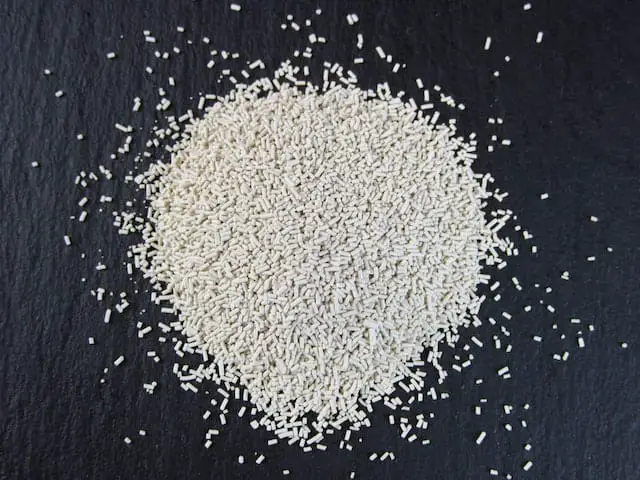In the baking world, there’s just too many products and terminologies out there that things can get easily overwhelming.
Just turn your attention to yeast for example. There’s already like a dozen type of them in existence, from the active dry yeast to deactivated, creamed and even compressed yeast. And now there’s the “pizza crust yeast” too.
What exactly is a pizza crust yeast and how does it differ from an instant yeast or the active dry yeast?
In this article, we’ll find out exactly what a pizza crust yeast is and what its similarities and differences are with the instant dry yeast.

What is instant yeast?
Instant yeast is simply a type of baker’s yeast that has the same structure as an active dry yeast but with smaller granules that makes it activate faster and therefore not require rehydration i.e. to be dissolved in a solution of warm water and sugar in order to “bring it back to life”.
Because you do not need to rehydrate instant yeast, it means that you can add it directly to the dry ingredients of baking such as flour, sugar and salt and mix directly until a homogeneous mixture is formed.
Doughs made with instant yeast also do not require a long rise time due to how fine the texture of the yeast strands are.
Such texture makes it very easy for the yeast to work its way into the dough and begin to perform its work. Typically, with an instant yeast, it’ll suffice to do only a single rest and rise for the dough.
Instant yeast is great for making quick breads.
What is pizza crust yeast?
A pizza crust yeast is a type of instant yeast that does not require proofing to be done when it’s used. In addition to this, pizza crust yeast are also fortified with dough relaxers to prevent snapping back of dough when rolled, and these relaxers can cause the dough to rise quickly in the oven.
So basically, a pizza crust yeast is a type of yeast to use when you’re in a hurry to bake pizza. It will make you a pizza dough in less than 30 minutes.
How does pizza yeast differ from instant yeast?
The main way pizza yeast differs from instant yeast is that pizza yeast contains L-Cysteine which is an amino acid that serves as a reducing agent for breaking down the proteins in gluten.
L-Cysteine helps to soften gluten and therefore relax dough. This is what makes dough not to shrink or spring back when you roll it.
Through this conditioning, a softer, better textured and high volume end result is achieved. Also, it becomes possible to mix, roll and bake pizzas without any proofing needed.
Another difference you’ll notice when comparing the instant dry yeast with the pizza crust yeast is that doughs made with the latter will have a much lower temperature, better consistency and will be easier to handle, even though the difference is by a small degree.
Can you substitute pizza yeast for instant yeast in a pizza dough recipe?
If you’re going the route of an “instant yeast” to make pizza, it means you want to achieve a quicker dough to begin with.
So yes, you can substitute pizza crust yeast for instant yeast in a pizza dough recipe and vice versa, and the major difference would be in the proofing time.
Pizza crust yeast doesn’t require any rise time and everything can be made in one go, whereas, when you’re using instant yeast, you’ll have to let the dough rise at least once.
Now there might be other differences in department such as texture, volume, quality and taste which we have talked about in the previous heading of “ How does pizza yeast differ from instant yeast”.
When it comes to substituting both pizza yeast and instant yeast in other baking applications (for instance bread making), you want to steer clear of using pizza crust yeast in any recipe other than pizza dough, especially bread recipes as the results can be terrible.
Is pizza crust yeast any good?
The truth is, yeast with such a fast action isn’t truly full proof. It has its own downsides too.
This is because the fast action comes with a sacrifice, and that sacrifice in a critical department for that matter. How the dough ends up tasting!
There isn’t a lot to say about the texture of pizza dough risen with a pizza crust yeast. The flavour isn’t as deep and impressive as if an instant or active dry yeast was would have been used. The crust isn’t that good and the overall aroma that comes with the traditional proofing method is simply missing.
So with a pizza crust yeast, you’re basically getting a decent product, but not the greatest you can ever get.
If you want to get a tasty dough with the traditional flavour and aroma slapped all across it, then make sure to opt for a yeast that requires proofing; the longer the better, or use an instant yeast that doesn’t have a fast or rapid rise action.
Is Fleischmann’s pizza crust yeast the same as active dry yeast or instant yeast?
No. Fleischmann’s pizza crust yeast isn’t the same as active dry yeast and it also differs from instant dry yeast in the sense that it contains L-Cysteine which acts as a dough relaxer.
How to use pizza crust yeast
Making pizza dough using a pizza crust yeast is easy.
First you need to create a starter mixture for the dough which combines part of your flour with 1 envelope of the yeast, sugar, salt and the liquids: water and oil in a bowl.
Soon after, mix properly for about 1 minute and gradually incorporate the rest of the flour until you arrive at a “slightly sticky dough”.
Knead (and keep adding flour if necessary) for about 4 minutes and then roll out the dough into a preferred size and place into a greased pan that will accommodate it with some space.
Top the pizza with a cheese or cheeseless topping and bake until the cheese is bubbly or toppings are perfectly cooked if you’re not using cheese.
Will active dry yeast work for pizza dough?
Active dry yeast can be used to make pizza dough. In fact, it could help develop a very deep artisanal yeast flavour.
Whenever you’re using this type of yeast, ensure that you activate the yeast by dissolving it in water having a temperature between 100°F to 110°F just so you don’t end up destroying the yeast with too hot of a liquid or keeping them “sort of dormant” with too cold of a liquid, and thereafter, add the yeast to the wet ingredients.
With an active dry yeast, you’ll typically require at least two rises.
